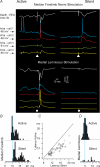Neuronal mechanisms mediating the variability of somatosensory evoked potentials during sleep oscillations in cats
- PMID: 15528249
- PMCID: PMC1665518
- DOI: 10.1113/jphysiol.2004.071381
Neuronal mechanisms mediating the variability of somatosensory evoked potentials during sleep oscillations in cats
Abstract
The slow oscillation (SO) generated within the corticothalamic system is composed of active and silent states. The studies of response variability during active versus silent network states within thalamocortical system of human and animals provided inconsistent results. To investigate this inconsistency, we used electrophysiological recordings from the main structures of the somatosensory system in anaesthetized cats. Stimulation of the median nerve (MN) elicited cortical responses during all phases of SO. Cortical responses to stimulation of the medial lemniscus (ML) were virtually absent during silent periods. At the ventral-posterior lateral (VPL) level, ML stimuli elicited either EPSPs in isolation or EPSPs crowned by spikes, as a function of membrane potential. Response to MN stimuli elicited compound synaptic responses and spiked at any physiological level of membrane potential. The responses of dorsal column nuclei neurones to MN stimuli were of similar latency, but the latencies of antidromic responses to ML stimuli were variable. Thus, the variable conductance velocity of ascending prethalamic axons was the most likely cause of the barrages of synaptic events in VPL neurones mediating their firing at different level of the membrane potential. We conclude that the preserved ability of the somatosensory system to transmit the peripheral stimuli to the cerebral cortex during all the phases of sleep slow oscillation is based on the functional properties of the medial lemniscus and on the intrinsic properties of the thalamocortical cells. However the reduced firing ability of the cortical neurones during the silent state may contribute to impair sensory processing during sleep.
Figures






Similar articles
-
Network modulation of a slow intrinsic oscillation of cat thalamocortical neurons implicated in sleep delta waves: cortically induced synchronization and brainstem cholinergic suppression.J Neurosci. 1991 Oct;11(10):3200-17. doi: 10.1523/JNEUROSCI.11-10-03200.1991. J Neurosci. 1991. PMID: 1941080 Free PMC article.
-
Intrinsic discharge patterns and somatosensory inputs for neurons in raccoon primary somatosensory cortex.J Neurophysiol. 1994 Dec;72(6):2827-39. doi: 10.1152/jn.1994.72.6.2827. J Neurophysiol. 1994. PMID: 7897492
-
Spontaneous and evoked activity of neurones in the somatosensory thalamus of the waking cat.J Physiol. 1971 Sep;217(2):359-79. doi: 10.1113/jphysiol.1971.sp009576. J Physiol. 1971. PMID: 5097605 Free PMC article.
-
Spike timing and synaptic dynamics at the awake thalamocortical synapse.Prog Brain Res. 2005;149:91-105. doi: 10.1016/S0079-6123(05)49008-1. Prog Brain Res. 2005. PMID: 16226579 Review.
-
Coalescence of sleep rhythms and their chronology in corticothalamic networks.Sleep Res Online. 1998;1(1):1-10. Sleep Res Online. 1998. PMID: 11382851 Review.
Cited by
-
Effects of Cortical Cooling on Activity Across Layers of the Rat Barrel Cortex.Front Syst Neurosci. 2020 Aug 4;14:52. doi: 10.3389/fnsys.2020.00052. eCollection 2020. Front Syst Neurosci. 2020. PMID: 32848644 Free PMC article.
-
Adenosine A1 receptors decrease thalamic excitation of inhibitory and excitatory neurons in the barrel cortex.Neuroscience. 2006;137(4):1177-84. doi: 10.1016/j.neuroscience.2005.10.022. Epub 2005 Dec 15. Neuroscience. 2006. PMID: 16343787 Free PMC article.
-
Bridging Single Neuron Dynamics to Global Brain States.Front Syst Neurosci. 2019 Dec 6;13:75. doi: 10.3389/fnsys.2019.00075. eCollection 2019. Front Syst Neurosci. 2019. PMID: 31866837 Free PMC article.
-
Temporal dynamics of cortical sources underlying spontaneous and peripherally evoked slow waves.Prog Brain Res. 2011;193:201-18. doi: 10.1016/B978-0-444-53839-0.00013-2. Prog Brain Res. 2011. PMID: 21854964 Free PMC article. Review.
-
Imbalance of neocortical excitation and inhibition and altered UP states reflect network hyperexcitability in the mouse model of fragile X syndrome.J Neurophysiol. 2008 Nov;100(5):2615-26. doi: 10.1152/jn.90752.2008. Epub 2008 Sep 10. J Neurophysiol. 2008. PMID: 18784272 Free PMC article.
References
-
- Achermann P, Borbely AA. Low-frequency (<1 Hz) oscillations in the human sleep electroencephalogram. Neuroscience. 1997;81:213–222. 10.1016/S0306-4522(97)00186-3. - DOI - PubMed
-
- Addy RO, Dinner DS, Luders H, Lesser RP, Morris HH, Wyllie E. The effects of sleep on median nerve short latency somatosensory evoked potentials. Electroencephalogr Clin Neurophysiol. 1989;74:105–111. 10.1016/0168-5597(89)90015-4. - DOI - PubMed
-
- Alloway KD, Wallace MB, Johnson MJ. Cross-correlation analysis of cuneothalamic interactions in the rat somatosensory system: influence of receptive field topography and comparisons with thalamocortical interactions. J Neurophysiol. 1994;72:1949–1972. - PubMed
-
- Arieli A, Sterkin A, Grinvald A, Aertsen A. Dynamics of ongoing activity: explanation of the large variability in evoked cortical responses. Science. 1996;273:1868–1871. - PubMed
Publication types
MeSH terms
LinkOut - more resources
Full Text Sources
Miscellaneous

